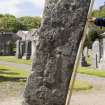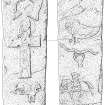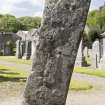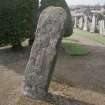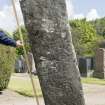Scheduled Maintenance
Please be advised that this website will undergo scheduled maintenance on the following dates: •
Tuesday 3rd December 11:00-15:00
During these times, some services may be temporarily unavailable. We apologise for any inconvenience this may cause.
Mortlach Parish Church, Burial-ground And Watch-house
Church (Medieval), War Memorial (20th Century)
Site Name Mortlach Parish Church, Burial-ground And Watch-house
Classification Church (Medieval), War Memorial (20th Century)
Alternative Name(s) Dufftown: War Memorial Chapel
Canmore ID 16798
Site Number NJ33NW 10
NGR NJ 32374 39285
Datum OSGB36 - NGR
Permalink http://canmore.org.uk/site/16798
First 100 images shown. See the Collections panel (below) for a link to all digital images.
- Council Moray
- Parish Mortlach
- Former Region Grampian
- Former District Moray
- Former County Banffshire
NJ33NW 10 32374 39285
(NJ 3238 3928) Church (NR)
Cathedral (NR) (Remains of)
OS 6" map, (1938)
See also Priest's Well, NJ33NW 3.
Traditionally a See was founded at Mortlach in 1011 or 1063 and transferred to Aberdeen in 1125. The evidence for this is spurious or suspect, but there may well have been at Mortlach a monastic bishopric of Celtic type, and a Monastery of 'Murthillac' is mentioned among the possessions of the Church of Aberdeen in a Papal Bull of 1157, though its existence is unsupported by definite evidence.
The present Church, of St Moloc or Moluag, was modernised in the 19th century, but incorporates some possibly 13th century work.
D MacGibbon and T Ross 1896-7; G Donaldson 1955; D E Easson 1957.
Mortlach parish church, restored in 1876 and 1931, parts of which probably date back to 1010 AD. St Moluag founded a monastery on this site about 566 AD. (Information from J S Stephen 1952 'Mortlach Church notes') The church and associated graveyard are still in regular use.
Visited by OS (N K B) 26 January 1967.
Publication Account (1986)
Mortlach is undoubtedly one of the earliest Christian sites in Grampian. Although it is not clear when the first shrine, chapel or hermitage was built, the (relatively late) tradition that at least three bishops had been based at Mortlach prior to 1140 is accepted by most scholars.
The present church, which is still set in a small kirk ton distinct from the much later planned town, dates from the 13th century. The chancel, with its narrow lancets, survives from what would have been a simple rectangular medieval church. The present modifIed 'T' plan stems from the extensions of 1826 and 1876. It was restored in 1931.
As well as the quiet focus provided by the dark chancel, Mortlach's interior contains many interesting furnishings. In the north wall is an arched recess with effIgy, the tomb of Alexander Leslie of Kininvie (d c 1549), while, opposite, is an unusual, if guileless, late 17th century monument to the Duffs of Keithmore. The stained glass includes work by Cottier (chancel) and Strachan (south wall), the latter with recognisable local views and a Canadian theme. In the vestibule is an important early Pictish stone with beast and rare curvilinear symbol which may have been based on a brooch, as well as several fme tombstones.
The kirkyard is full of interest, including a little watchhouse, a line of confident distillers' tombs and a Pictish stone, the Battle Stone, bealing on one side a cross between two fish monsters and a serpent, a bull's head and a horse and lider on the other.
Information from ‘Exploring Scotland’s Heritage: Grampian’, (1986).
Publication Account (1996)
Mortl ach is undoubtedly one of the earliest Christian sites in North-east Scotland. Although it is not clear when the first shrine, chapel or hermitage was built, the (relatively late) tradition that at least three bishops had been based at Mortlach prior to 1140 is accepted by most scholars.
The present church, which is still set in a small kirkton distinct from the much later planned town, dates from the 13th century. The chancel, with its narrow lancets, survives from what would have been a simple rectangular medieval church. The present modified 'T' plan stems from the extensions of 1826 and 1876. It was restored in 1931.
As well as the quiet focus provided by the dark chancel, Mortlach's interior contains many interesting furnishings. In the north wall is an arched recess with effigy, the tomb of Alexander Leslie of Kininvie (d c 1549), while, opposite, is an unusual, if guileless, lare 17th-century monument to the Duffs of Keithmore. The stained glass includes work by Cottier (chancel) and Strachan (south wall ), the latter with recognisable local views and a Canadian theme. In the vestibule is an important early Pictish stone with beast and rare curvilinear symbol which may have been based on a brooch, as well as several fine tombstones.
The kirkyard is full of interest, including a little watch-house, a line of confident distillers' tombs and a Pictish cross-slab, the Battle Stone, bearing on one side a cross between two fish monsters and a beast, and, on the other, a serpent, a bull's head and a horse and rider.
Information from ‘Exploring Scotland’s Heritage: Aberdeen and North-East Scotland’, (1996).










































































































